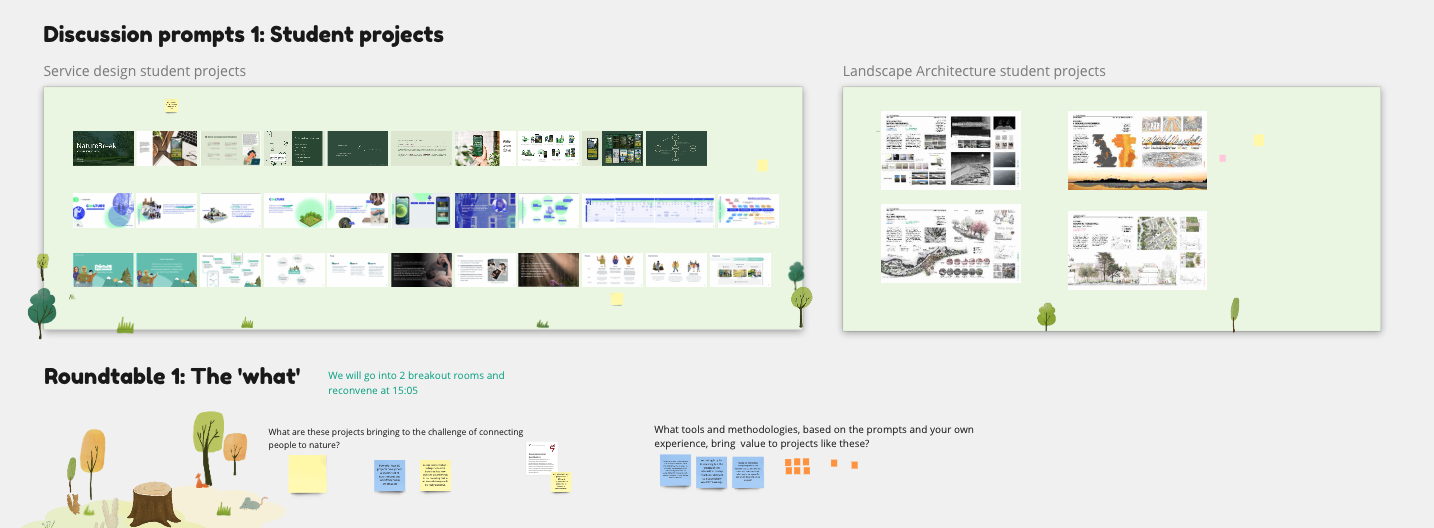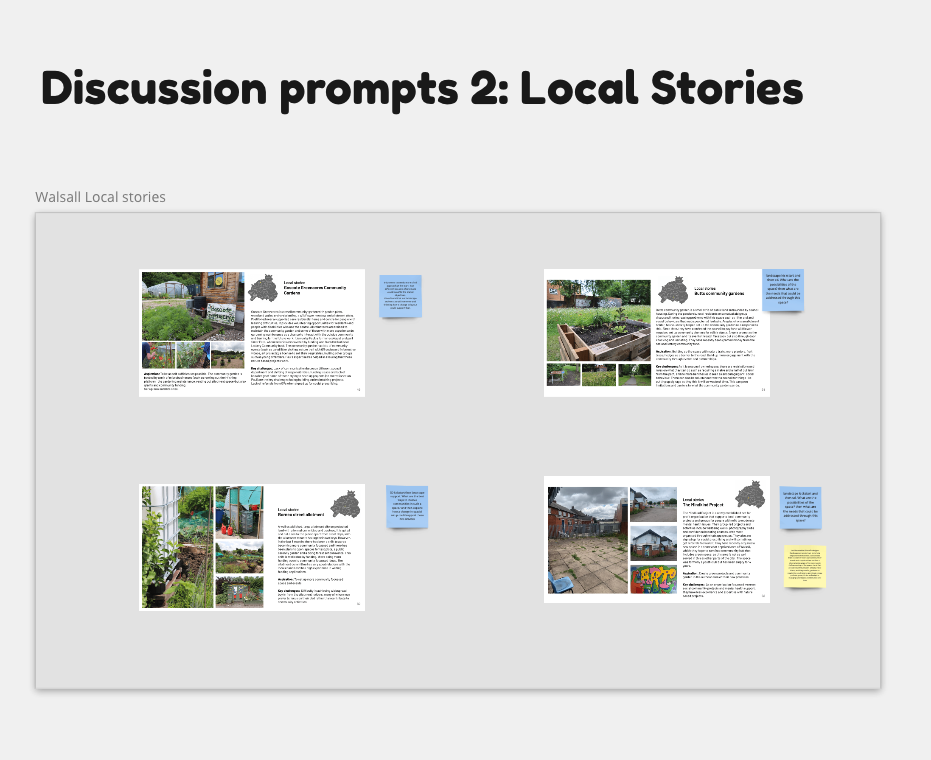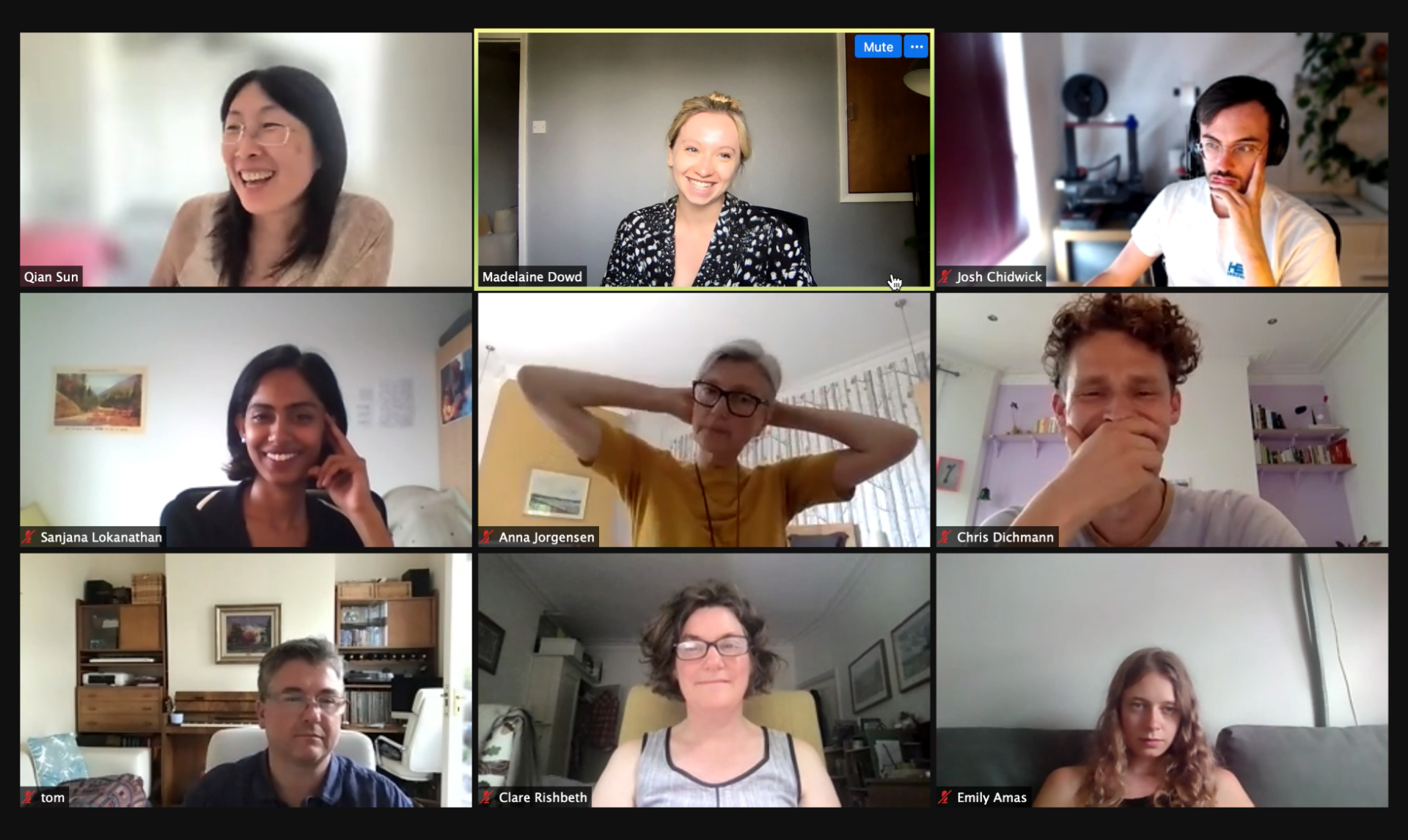Do design and designers have a role to play in Nature based Solutions for wellbeing, and if so, what might that role look like?
The value that design could bring to community led NbS is a key area of exploration in the Nature’s Way project. Our early thinking had led us to hypothesise that approaches from the disciplines of service design and landscape architecture (in particular human centred and place based approaches respectively) have the potential to address the challenges community NbS projects may face. Through actively doing and reflecting on the design of the pilots and platform while working with local communities, frontline providers and decision makers, we are attempting to find whether this is the case and in what way.
Part of our investigation has also involved talking to the design community – especially those with experience working in social innovation around nature. Following on from the student reflection workshop in June, we invited a group of service designers, social design practitioners and landscape architects to an online 2 hour roundtable workshop in July 2021. Of the 16 attendees who kindly volunteered their time, we had a mix of recent graduates, practicing professionals and academics.
Workshop structure
The workshop was in 2 parts, each consisting of reviewing discussion prompts then breaking into groups for a semi- facilitated discussion – allowing for open discussions that went in unexpected directions!
In part one, the aim was to explore what each of the design disciplines could bring to the table to address the challenge of connecting people to nature – in terms of approaches, tools, methodologies – and the differences and similarities between the two. For the discussion prompts, we provided excerpts from student projects that all explored this challenge from various perspectives. These included group projects from RCA’s MA Service Design course, working from a brief set by Nature’s way earlier this year, and individual prize winning projects from University of Sheffield’s MA Landscape Architecture.
MA Service Design:
- Naturebreak by Ziwei Liu & Huizi Zhang
- Coolture by Yusuke Kanda, Arif Yusop, Cristiana Stanciu, Suhyeon Jo
- Brightside by Serene Yap, Debby Hsiao, Nini Lin, Jiaqi Wang & Yantin Shen
MA Landscape Architecture:
- Beyond the Seawall by Sanjana Lokanathan
- All that remains by Emily Amas
- Rerooting Powderhall by Zoe Dobson
- A Coalfields Pilgrimage by Sally Smith

For part two, we explored the role of the designer or architect in nature-based community projects and whether this may be affected by the new challenges brought on by the pandemic. We showed local stories from Walsall community groups who are either currently doing or starting to do nature based projects. These stories and photos came from our initial field work in Walsall, which we chose to show the diversity of place, progress, experience and challenges.
These were:
- The Mindkind Projects (our local partner!)
- Goscote Greenacres Community Gardens
- Borneo street allotment
- Butts community gardens

Key takeaways
Disciplinary differences and opportunities for synergy
A lively discussion was had on the differences and similarities of approach between the two disciplines, stemming from student projects and from the participants’ prior experience. Some felt that service design and landscape architecture have differing starting points: people and the social system for the former, the site and its characteristics in the latter. Differences in focus for design intervention was also noted. Service designers appeared more concerned with what people do in a space and their barriers to access, designing often technological interventions that tackled societal, behavioural or belief based obstacles to engagement. An example of such obstacles included the fear of being perceived as lazy if going to a greenspace during work hours (a key challenge addressed by NatureBreak). Landscape architects, on the other hand, generally focussed more on tangible elements of the site’s environment. They may aim to encourage people to engage with nature through the specific ways the site is designed, but tend not to ascribe activities. However, this is not to say the two disciplines are so cleanly divided – the most successful shows a deep, holistic consideration of the social, technological, environmental and cultural entanglements that affect how people engage with the nature that surrounds them. Thus, the participants agreed there are opportunities for mutual strengthening through collaboration, learnings and integration between the two.
Getting to the specifics of nature and specifics of community
A resounding message that came from the session was the importance of specifics when thinking, talking and designing around nature. Nature is not one thing, and the way in which most of us have meaningful engagement with it is through specific moments or reasons. From a glimpse of a territorial robin’s red chest, to eating a tomato that you grew from a seed, to smelling autumn in the earthy mushroom aroma – the interactions we remember, the wonder we feel and the stories we tell are hardly ever in the abstract. Any design intervention needs to avoid falling into thinking of Nature (with a capital N) as one benevolent entity, or risk further disinterest, disengagement or even disenchantment when the specifics of nature do not match the Nature of people’s expectations.
Similarly, the cultural, local and social specificity is equally as important. There are a myriad of reasons why someone may or may not want to engage with the natural world. As one participant aptly put it, it is not always the case that ‘if you build it, they will come’. Understanding the ‘user’ is a key principle in all design disciplines – the challenge here is the interactions between the specificities of nature and people, and whether another ‘function’ (such as food, social walks, conservation, arts & craft, exercise, citizen science) is needed to act as an intermediary.
Knowledge, aesthetics and narrative
Though not exclusive to design, participants made observations on some significant challenge areas regarding engagement with nature. One participant felt there was a large decrease in ecological knowledge not only in the general public, but also within local government – risking a lack of understanding on what the right actions might be in managing public green-spaces and in supporting local projects. Another challenge that stems from the previous is the public perception of what ‘nature’ should look like. Complaints of unkemptness and neglect can stymie projects like re-wilding initiatives. This is entangled with the deep narrative people may have of a place. Being able to change the narrative through interesting communication design thus could have a disproportionate effect on how people think about and engage with a particular place or aspect of nature. This could be hyperlocal ( e.g. a sign that recounts the history of a tree in your local park) to national or even international (e.g. ‘save the bees’ leading to wider acceptance of wildflower meadow verges). Designer and the skills they bring could have large impact in these areas.
Participants:
A huge thank you to all of our participants who volunteered their time and thoughts for this session:
Nicolas Rebolledo
Francesco Cagnola
Clive Grinyer
Christoph Dichmann
Becky Miller
Josh Chidwick
Sally Smith
Sanjana Lokananthan
Emily Amas
Andy Clayden
Clare Rishbeth
David Buck
Joseph Claghorn
Armina Pilav
Tom Wild
Astha Jothri
